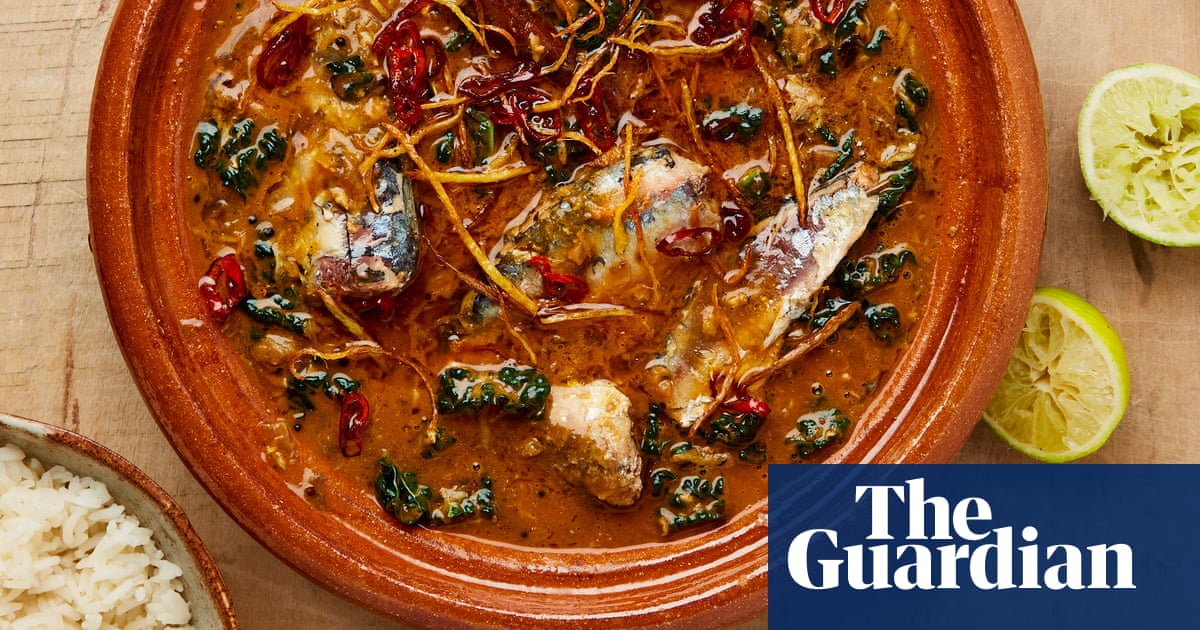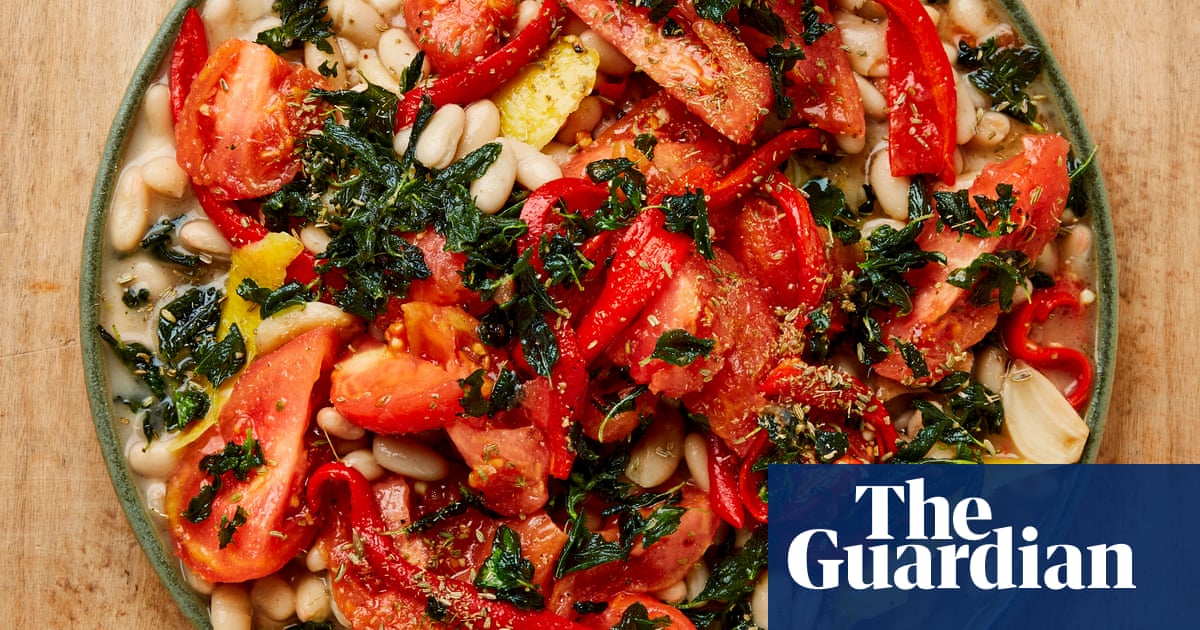
egumes: small things, but what a big world. There are thousands of species of legume, and even those we so often have in our cupboards have all sorts of variables: dried, tinned or jarred; whole or split; hulled or unhulled. No recipe calls for just “lentils”: they’re red, green, brown or black. They’ll be dried or tinned; beluga or puy; urad, channa, masoor, toor, moong … And within this vast range comes huge versatility. This week, I’m using a mix of dried, tinned and jarred legumes. They’re all very different, but they all hold their shape, they all soak up the flavours with which they are cooked – and they will all transport you to very different places.
Tamarind greens and mung beans with turmeric oil (pictured above)
This echoes the flavours of southern Iran, with a few additions and tweaks. It works as a vegetarian main (serve it with fluffy white rice or flatbread) or as a side to all sorts of things: pan-fried tofu, say, or grilled prawns.
Prep 30 min
Cook 1 hr 20 min
Serves 4
105ml olive oil
2 large onions, peeled and thinly sliced (420g net weight)
10 garlic cloves, all peeled, 5 crushed and 5 thinly sliced
2 green chillies, finely chopped, seeds and all (25g)
2 tsp cumin seeds, roughly crushed in a mortar
1 tsp mild curry powder
1 tbsp tomato paste
120g mung beans, soaked in cold water for at least 1 hour, then drained
1kg swiss chard, stalks removed and reserved for another use, leaves roughly shredded (480g)
1 tsp caster sugar
Salt and black pepper
3 tbsp tamarind paste
40g fresh coriander, roughly chopped, plus a handful of extra picked leaves to serve
½ tsp ground turmeric
½ tsp chilli flakes (optional)
½ lemon
130g Greek-style yoghurt
Put a large saute pan for which you have a lid on a medium-high heat, and add four tablespoons of oil. Once it’s hot, add the onions and cook, stirring occasionally, for 15 to 18 minutes, until soft and browned. Transfer a third of the onions to a bowl, then add the crushed garlic, chilli, spices and tomato paste to the onion pan and cook, stirring, for a minute more, until fragrant.
Add the drained mung beans and 800ml water, bring up to a boil, then turn down the heat to medium, cover and simmer gently, stirring occasionally, for 30-35 minutes, until the beans have softened but still retain their shape. Add the chard, sugar, a teaspoon of salt and a good grind of pepper, replace the lid and cook for another 10 minutes. Remove the lid and cook for 10 minutes more, until the chard has softened and the liquid has thickened. Stir in the tamarind and coriander, and keep warm on a low heat until you’re ready to serve.
Towards the last 10 or so minutes of cooking, put the remaining three tablespoons of oil and the sliced garlic in a small frying pan on a medium heat. Cook, stirring occasionally, for about 12 minutes, until the garlic is lightly golden, then stir in the turmeric and chilli flakes, and turn off the heat.
Transfer the bean mixture to a large, shallow bowl and squeeze over the lemon half. Top with spoonfuls of yoghurt followed by the reserved onions, then spoon over the crisp garlic slices and their oil. Garnish with a handful of picked coriander and serve warm.
Lamb shanks with beluga lentils and apricots
This dish is inspired by dal makhani, that buttery Indian dish made rich by the sheer amount of cream or ghee in which the black lentils and red kidney beans are cooked. This is a simplified version, less rich, and with added sweetness from the apricots.
Prep 25 min
Cook 3 hr 35 min
Serves 4, generously
3 tbsp ghee
2 lamb shanks (800g net weight)
Salt and black pepper
30g piece fresh ginger, peeled and finely grated
6 garlic cloves, peeled and crushed
2 green chillies, finely chopped, seeds and all (20g)
1 onion, peeled and finely chopped (180g)
2 tsp garam masala
2 tsp ground cumin
50g tomato paste
100g soft-dried apricots, quartered
220g dried beluga lentils
1 x 400g tin kidney beans in water (240g), drained
50ml double cream, plus 1½ tbsp extra to serve
1 tsp caster sugar
For the apricot salsa
80g soft-dried apricots, roughly chopped and soaked in hot water for 20 minutes
4 tbsp (15g) fresh coriander, roughly chopped
3 limes – zest finely grated, to get 1½ tbsp, and juiced, to get 2 tbsp
3 tbsp olive oil
Heat the oven to 200C (180C fan)/390F/gas 6.
On a high heat, melt two tablespoons of the ghee in a large, oven-proof cast-iron saucepan for which you have a lid. Season the lamb shanks with half a teaspoon of salt, then sear them in the hot fat for six minutes, turning as necessary, until they’re golden all around. Transfer to a plate and leave the pan to cool slightly.
Return the pan to a medium heat, add the ginger, garlic and chillies, and saute, stirring occasionally, for three minutes, until fragrant. Add the onion, cook, stirring, for three minutes more, then add the garam masala, a teaspoon of cumin and the tomato paste, and cook for another five minutes, until the oil separates. Return the shanks to the pan, add the apricots and a litre and a quarter of water, and bring to a boil. Cover the pot, transfer it to the oven and bake for 90 minutes.
Remove from the oven and use tongs gently to lift out the shanks and transfer them to a plate. Stir the lentils, beans, cream, sugar, three-quarters of a teaspoon of salt and a good grind of pepper into the pan, then return the lamb to the mix. Cover again and bake for another 90 minutes, until the lamb is fork tender and the lentils are soft – give it all a good stir halfway through, and add a splash more water if the sauce is too thick. Stir in the last tablespoon of ghee and set aside.
While the lamb is cooking, make the salsa. Drain the apricots, then put in a medium bowl with the coriander, lime juice and zest and oil, toss to combine and set aside.
Gently transfer the shanks to a plate. Spoon the lentil mixture on to a large, shallow platter, sprinkle with the remaining teaspoon of cumin powder and drizzle with the extra cream. Top with the shanks, spoon over the salsa and serve.
Butter beans with preserved lemon, chilli and herb oil
These are inspired by the flavours of the Mediterranean. They intensify with time, so ideally make them a day ahead, so everything sits together overnight. Once made, the beans will keep in a sealed container in the fridge for up to three days. Try to use good-quality, jarred butter beans: they’ll make a world of difference. Serve with crusty bread to mop it all up.
Prep 20 min
Cook 40 min
Infuse 1 hr+
Serves 4 as a meze
5 garlic cloves, peeled and finely chopped
2 mild red chillies, finely chopped, seeds and all (30g net weight)
1 tbsp coriander seeds, finely crushed in a mortar
3 preserved lemons (80g), inner parts discarded and skin finely sliced (45g)
1½ tbsp picked thyme leaves, roughly chopped
4 rosemary sprigs
1 tbsp tomato paste
175ml olive oil
Flaked sea salt and black pepper
1 x 700g jar good-quality large butter beans, drained (550g net weight) – I like the El Navarrico brand
2 large vine tomatoes (220g), roughly grated and skins discarded (120g)
Put the first eight ingredients and a quarter-teaspoon of flaked salt in a medium saute pan on a medium-low heat. Stir everything together and heat gently for 25 minutes, until very fragrant but not at all coloured (if the oil gets too hot, turn the heat down low).
Stir in the butter beans, turn the heat up to medium and cook for 10 minutes, until the oil just starts to bubble. Turn off the heat and leave to infuse for at least an hour, and preferably overnight.
Meanwhile, mix the grated tomato with half a teaspoon of flaked salt and a good grind of pepper.
Pour the butter bean mixture into a shallow bowl, spoon over the grated tomato, mixing it in a little in places, and serve at room temperature.












